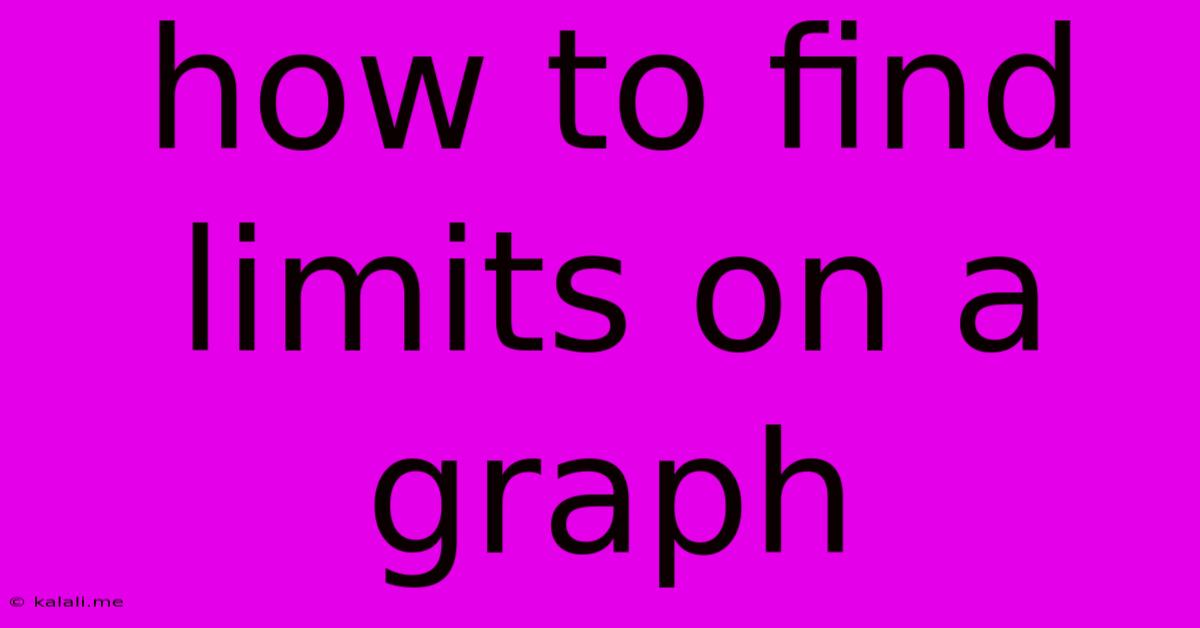How To Find Limits On A Graph
Kalali
Jun 08, 2025 · 4 min read

Table of Contents
How to Find Limits on a Graph: A Visual Guide
Finding limits on a graph is a fundamental concept in calculus. Understanding how to visually determine limits from a graph is crucial for grasping the broader concepts of continuity, derivatives, and integrals. This article will guide you through various scenarios and techniques for accurately determining limits directly from a graph. This guide is perfect for students learning calculus or anyone refreshing their understanding of graphical limit analysis.
What is a Limit?
Before diving into graphical analysis, let's briefly define a limit. The limit of a function f(x) as x approaches a value c (written as lim<sub>x→c</sub> f(x) ) describes the value that the function approaches as x gets arbitrarily close to c. It's important to note that the limit doesn't necessarily equal the function's value at c. The function may be undefined at c, or its value at c could be different from the limit.
Identifying Limits Graphically: Different Scenarios
There are several scenarios you might encounter when visually identifying limits on a graph:
1. Limits at a Point of Continuity:
This is the simplest scenario. If the function is continuous at point c, the limit as x approaches c is simply the function's value at c. Look at the graph; if there's a solid point at c, and the curve approaches this point smoothly from both the left and right, the limit is the y-coordinate of that point.
2. One-Sided Limits:
Sometimes, the function approaches different values as x approaches c from the left and the right. These are called one-sided limits:
- Left-hand limit (lim<sub>x→c<sup>-</sup></sub> f(x)): The value the function approaches as x gets closer to c from values less than c.
- Right-hand limit (lim<sub>x→c<sup>+</sup></sub> f(x)): The value the function approaches as x gets closer to c from values greater than c.
If the left-hand and right-hand limits are equal, then the overall limit exists and is equal to their common value. If they are unequal, the limit at c does not exist.
3. Limits Involving Asymptotes:
Asymptotes are lines that the graph approaches but never touches. Horizontal asymptotes indicate the behavior of the function as x approaches positive or negative infinity. Vertical asymptotes often indicate that the limit at a certain x value does not exist.
- Horizontal Asymptotes: If the graph approaches a horizontal line y = L as x goes to infinity (positive or negative), then lim<sub>x→∞</sub> f(x) = L or lim<sub>x→-∞</sub> f(x) = L.
- Vertical Asymptotes: If the graph approaches infinity or negative infinity as x approaches a specific value c, then the limit at c does not exist. You may express this as lim<sub>x→c</sub> f(x) = ∞ or lim<sub>x→c</sub> f(x) = -∞, but it's crucial to remember that these are not actual limits, but rather descriptions of the function's behavior.
4. Jump Discontinuities and Removable Discontinuities:
- Jump Discontinuities: These occur when the left-hand and right-hand limits exist but are unequal. The limit at the point of discontinuity does not exist.
- Removable Discontinuities: These occur when there's a "hole" in the graph. The function is undefined at that point, but the left-hand and right-hand limits are equal. In such cases, the limit exists and is equal to the common value approached by the function.
Tips for Accurate Limit Determination:
- Trace the curve: Carefully follow the curve of the function as x approaches the point in question from both the left and the right.
- Consider the scale: Pay close attention to the scaling of the axes to avoid misinterpretations.
- Look for patterns: Recognize common function behaviors associated with different types of limits.
- Use a ruler (optional): Using a ruler to visually extend the approaching portions of the graph can assist in determining the limit value.
By understanding these scenarios and applying these tips, you'll significantly improve your ability to find limits directly from a graph, strengthening your understanding of this core calculus concept. Remember to always analyze the function's behavior from both sides of the point in question. Practice with various examples, and you'll become proficient in determining limits graphically.
Latest Posts
Latest Posts
-
Pros And Cons Of Whole House Humidifier
Jun 09, 2025
-
How To Fix Ripped Paint On Wall
Jun 09, 2025
-
What Will Keep Sugar Free Ice Cream From Getting Icy
Jun 09, 2025
-
Would You Mind A Schedule Meetring Some Time
Jun 09, 2025
-
How To Tune A Guitar Down A Half Step
Jun 09, 2025
Related Post
Thank you for visiting our website which covers about How To Find Limits On A Graph . We hope the information provided has been useful to you. Feel free to contact us if you have any questions or need further assistance. See you next time and don't miss to bookmark.